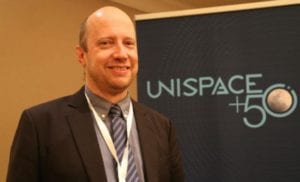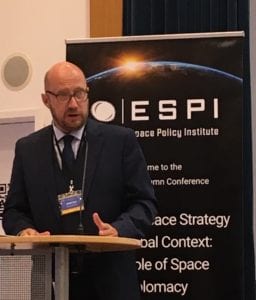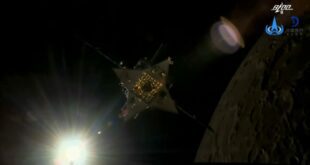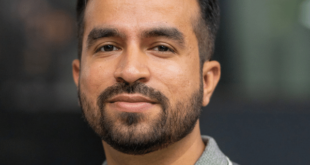SpaceWatch.Global recently caught up with Andre Rypl, Chair of the 62nd session of the UN COPUOS, to get an update on the 21 Guidelines for the Long-Term Sustainability of Outer Space Activities.
 Thank-you for the opportunity to provide some background information and details on the 21 Guidelines for the Long-Term Sustainability (LTS) of Outer Space Activities. The LTS are the visible and concrete result of many years of negotiation and effort and provide a framework of important principles and procedures that each country can adopt to ensure that space remains sustainable and accessible for more and more countries in the future. There is a huge and ever-increasing reliance on space technology in our everyday lives. From mobile and smartphones, maps, traffic apps, emails, messaging or the web, we often take for granted that for these we are using space technology. And medicine, monitoring disasters, nature and the environment these too are very much dependent on space. So, the contribution of the 21 Guidelines is enormous because of this interdependency of vital everyday systems. Equally important is that they represent the first concrete achievement of the Committee on the Peaceful Use of Outer Space since 2007. Over the last 10 years, we managed to get all Member States not only to reach an agreement, but equally importantly, the Committee also concluded that because space is constantly evolving, we need to continue our discussion and focus on additional elements. In the past, we had the USSR and United States striving to be the first to land on the Moon. In the 70s, we had the ISS. Interest in space was then reduced to a point where the US discontinued the shuttle program. Now we are seeing a renaissance more akin to what was experienced in the 60s, with far more countries able to launch payloads into orbit. We also have huge interest in space from the private sector. We’ve seen Elon Musk launch a car into space. We see plans to go to Mars. We see the project of a gateway around the moon which could serve as a launch base for deep space missions. So, this revival of space should walk hand in hand with a shared vision for the development of rules which ensure that space remains sustainable.
Thank-you for the opportunity to provide some background information and details on the 21 Guidelines for the Long-Term Sustainability (LTS) of Outer Space Activities. The LTS are the visible and concrete result of many years of negotiation and effort and provide a framework of important principles and procedures that each country can adopt to ensure that space remains sustainable and accessible for more and more countries in the future. There is a huge and ever-increasing reliance on space technology in our everyday lives. From mobile and smartphones, maps, traffic apps, emails, messaging or the web, we often take for granted that for these we are using space technology. And medicine, monitoring disasters, nature and the environment these too are very much dependent on space. So, the contribution of the 21 Guidelines is enormous because of this interdependency of vital everyday systems. Equally important is that they represent the first concrete achievement of the Committee on the Peaceful Use of Outer Space since 2007. Over the last 10 years, we managed to get all Member States not only to reach an agreement, but equally importantly, the Committee also concluded that because space is constantly evolving, we need to continue our discussion and focus on additional elements. In the past, we had the USSR and United States striving to be the first to land on the Moon. In the 70s, we had the ISS. Interest in space was then reduced to a point where the US discontinued the shuttle program. Now we are seeing a renaissance more akin to what was experienced in the 60s, with far more countries able to launch payloads into orbit. We also have huge interest in space from the private sector. We’ve seen Elon Musk launch a car into space. We see plans to go to Mars. We see the project of a gateway around the moon which could serve as a launch base for deep space missions. So, this revival of space should walk hand in hand with a shared vision for the development of rules which ensure that space remains sustainable.
Can you please highlight one or two of the 21 Guidelines and describe how concrete they are?

The guidelines are divided into different aspects. For example, we have guidelines that address space situational awareness and space traffic management. These guidelines encourage countries to develop standards, share information and develop practical approaches to areas such as assessing the risk of collisions in space, identifying whether a launch will cross the path of any other object or even a piece of debris. Take space debris as another example. We already have space debris mitigation guidelines, but we also need to address the removal of debris. So, with these two very practical issues, we are creating conditions for an international system to address these problems. Currently, regarding Space Traffic Management (STM) or Space Situational Awareness (SSA), each country is free to develop their own standards and their own tracking system to monitor fragments and objects in space. And because this practice may relate to national security issues, countries are not forced, or indeed encouraged to share this information. Today, if you get a report of possible reentry of a fragment of debris or a satellite, you don’t really have any official mechanism that tells you to inform other countries what is happening, and the risks involved. Who should be informed? What kind of preparations should be made? What is the level of preparedness? This is all up to individual countries. So, when we establish guidelines, we want parties to agree on specific standards to share information and conduct collision assessment studies ahead of launch. But there is still a lot of work to be done. In the case of STM and SSA, we have the register of space objects in the UN, in the Office for Outer Space Affairs, but the information that is provided does not follow a template and it is not standardized. Each launching state can provide their own information, with different levels of detail. We are not judging or assessing whether the information provided is sufficient to ensure that operations in space remain safe. And accidents do happen, such as the collision between the Kosmos satellite and Iridium in 2009. So we need a core set of information-sharing approaches and good practice standards to ensure that space is safe for everyone. We have to raise awareness of the importance of managing this together and we can learn a lot from organizations such as the International Civil Aviation Organization, and the Montreal Convention, and their definition of rules and procedures for air traffic. But we should also understand that space has a non-geographic nature. With the exception of the Second World War, we haven’t had a major incident involving nuclear weapons. But even if we had had, the explosion of a bomb, although it would contaminate the environment, it would be restricted geographically, affecting mainly the country that is bombed. In space, that’s not the case. Countries are starting to realize that there is not really a level of acceptable risk that we can live with. So regarding the guidelines, I gave two practical examples of their application, but there is also a political aspect involved that has to do with the idea that countries have to work together, they have to talk, and they have to make commitments. They have to make commitments in their legal frameworks to adopt the guidelines, and then adapt legal frameworks to translate these guidelines into practice. One of the discussions we will be having in the coming year focuses on implementation and the associated practical aspects, including the difficulties that individual countries face in applying the guidelines and how we can assist each other.
After a 10-year process, the guidelines have now been adopted. What comes next in terms of implementation?
A number of things are on the agenda regarding implementation. We have the 21 Guidelines and the Preamble, which sets the tone of the guidelines. It’s worth really trying to digest the information in the Preamble, because it’s basically a declaration of principles and what the Guidelines hope to achieve. Then we have to discuss how each country implements them. And some guidelines pose particular challenges, for example, for new space players. Maybe such countries don’t have the necessary expertise, or technical know-how to implement certain items. Perhaps some of the guidelines are not clear, because they are the product of more than 80 countries putting language together, so the text may require further clarification. I imagine we may also find that as technology develops, or new technology is adopted, or more players become participants in this process, some guidelines will be viewed as not sufficiently effective or efficient. We may realize that although we had a specific objective in mind when we designed a guideline, this is in fact not happening because a certain technology is no longer used. Or maybe this is not implementable, because so many players are doing different things that we cannot take a specific approach that was proposed, so we have to look at the problem from a different perspective. So the guidelines will need to undergo a periodic review process, and then they can be amended. And then, just as important as adopting the 21 guidelines and the preamble, we agreed that we will move further with this important work. We will set up a new process on LTS starting next year, which will be discussed in February, during the session of the Scientific and Technical Subcommittee. A new working group will continue working on the guidelines in terms of implementation, exchange of information and review, but also address proposals for new guidelines. So as technology develops, and new actors come into play, participants will be able to highlight any problems that we hadn’t foreseen and we can develop new guidelines to address them. One thing that we learned from this long process of preparing 21 guidelines is that we need to find a more objective approach. We cannot wait for 10 years to develop a new set of guidelines or to revise any that are not really practical in terms of implementation. My expectation is that member states will come with different ideas on how to approach this. Perhaps working with groups of experts first to analyze new proposals and then a group of diplomats meeting for the political discussions on how to do it in practical terms. I think we need to be flexible; we need to adapt and we have to find creative solutions to make sure that the negotiations will continue.
You spoke about the democratic process. Does it mean there is always consensus?

Yes, always. Working multilaterally is very complicated, because you need consensus. I understand consensus is not perfect, because it’s time consuming. But if you are talking about rules and behavior in space and how to make this effective and ensure implementation, people have to buy into the idea, they have to decide this is a good idea, that we should follow these guidelines. We cannot force people or countries to adopt a specific behavior. These are only guidelines, and they are voluntary. So, consensus and multilateral discussions are the best way to promote their implementation. The whole process is also about raising awareness. People have to understand why these things are important. A few years ago, we had a proposal by the European Union for a code of conduct for Outer Space activities and that was a very interesting text. In the end, however, the whole process folded precisely because some key actors were not involved in drafting the text. When you compare that to what we do here in Vienna, where decisions are consensus based, well, it takes more time to agree on something, but once we agree, we find that everybody is really committed to it. And this means that countries that are established space players sit with new and potential entrants to learn together. So, this also encourages established players with a large space program to support less established players in starting to develop space activities in a sustainable manner. This ensures that these new entrants are doing the right things from the beginning. And this would not happen if you didn’t have this whole consensus-based discussion.
Thank you very much for your insights. And finally, what got you into space? What gets you up in the morning to work in the space sector?
I’ve always liked science and science fiction as a kid. And space has the power to capture your imagination. With space there is a sense of discovery, the idea that we can go and explore where nobody has been before. Space is also the concept of something new, a place where we can go beyond our limits. I remember first time I came to Vienna in 2013 for the legal subcommittee and I was intrigued about the discussions on the definition of outer space, space debris and sustainability. I realized that these are important things and I could make a difference by playing a small part in ensuring that space will be used for all. So, when you think, okay, I can play a little part in this. I think that that’s what motivates me.*
*The views and opinions expressed in this interview are the sole responsibility of the author and do not necessarily reflect the positions of the Government of Brazil.
 Bio: Andre Rypl is a career diplomat who has been working with space issues since 2012. He has participated in several negotiation processes such as the proposal for an International Code of Conduct for Outer Space Activities, the guidelines on the long-term sustainability of outer space activities and the COPUOS Space 2030 Agenda. He is an advocate of increased interaction between different UN bodies, NGOs, academia, the private sector and other space stakeholders to promote the responsible, peaceful and sustainable use of outer space. He is the current chair of COPUOS and lives in Vienna, where he works at the Brazilian Embassy.
Bio: Andre Rypl is a career diplomat who has been working with space issues since 2012. He has participated in several negotiation processes such as the proposal for an International Code of Conduct for Outer Space Activities, the guidelines on the long-term sustainability of outer space activities and the COPUOS Space 2030 Agenda. He is an advocate of increased interaction between different UN bodies, NGOs, academia, the private sector and other space stakeholders to promote the responsible, peaceful and sustainable use of outer space. He is the current chair of COPUOS and lives in Vienna, where he works at the Brazilian Embassy.





